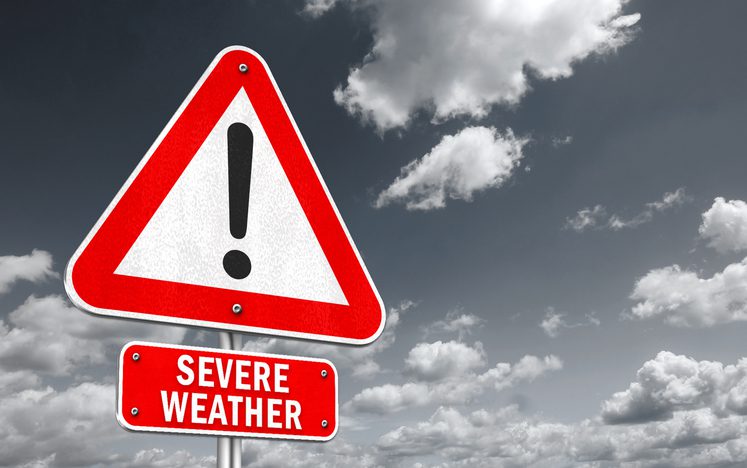Living in Florida, I’ve dealt with my fair share of extreme weather. I’ve experienced hurricane damage to my home and my community during the rainy season and drought during the dry season. In addition, wildfires have come close enough to my community to engulf it in smoke for nearly a week on several occasions.
In a severely drought-prone area, chronic drought conditions can last months or even years. These types of droughts can cause dangerous water shortages and wildfires resulting in destruction of property, economic hardship, and health issues. Therefore, it’s especially important to prepare your family and home before a drought strikes.
What Is a Drought?
A drought is a prolonged period in which less rain falls than is typical for that time of year. This results in drier conditions and can lead to a water shortage. All areas of the United States may experience a period of reduced rainfall, and thus, a drought.
Droughts are serious events that can result in widespread loss for communities in the affected areas. People who live in agricultural areas can lose their businesses, their livelihoods, and even their homes when crops, land, and income dry up. They can also develop health problems due to poor air and water quality, as well as mental health problems due to drought-related economic losses. Furthermore, droughts can cause damage that impacts the area’s wildlife, causing extreme stress because of decreased access to water and vegetation and habitat destruction.
How Can You Save Water in Drought-Prone Areas?
If you’re facing a drought-induced water shortage in your area, there’s a lot you can do to help conserve water.
Repair and retrofit plumbing
A faucet leaking one drop per second wastes over 2,000 gallons of water a year. To prevent this from happening in your home, regularly inspect your plumbing fixtures, hoses, and washers and replace as necessary to reduce leakage. You can further reduce water waste by installing aerators on your faucets and flow restrictors on your showerheads. These are available at most home improvement stores.
Save used water
“Using greywater” or “water recycling” means collecting and saving the water used to brush your teeth, wash your face, take a bath, or do the dishes for reuse around your house and lawn (e.g., to water plants). Outside, consider installing a rain barrel from your local agricultural extension office or home improvement store so that when it does rain, you can collect the rainwater to reuse it outdoors as needed.
Rethink your landscaping
The practice of planting native species and reducing lawn areas (which require heavy watering to maintain) is called xeriscaping and is very common in drier places such as Arizona, New Mexico, and even Utah.
Contact your local agricultural extension office to learn how to landscape with native, drought-tolerant plants. These grasses, ground covers, shrubs, and trees are best suited to survive a drier climate so require less watering and may be able to survive a dry period without any watering at all. You can also use mulch to both retain moisture in the soil and control weeds that compete with your plants for water.
Minimize pollution
Toxins can contaminate groundwater, making it unsafe for consumption and reducing an already limited water supply. To counteract this, reduce your use of chemicals when cleaning your home and car and when fertilizing your lawn. Securely store all chemicals that you do use to avoid spillage.
You can learn how to make non-toxic cleaners (e.g., those made at home from vinegar, baking soda, and hydrogen peroxide), which are generally safer for you and your water supply. In addition, consider using compost instead of chemicals to fertilize your lawn. You can learn more about composting through your local agricultural extension office.
Be aware of water restrictions
Check with your local water utility for information on water usage restrictions. These may include limits on how often or when you can wash your car or water your lawn, as well as restrictions on indoor water usage. Although some of the restrictions may be voluntary, adhering to them can help your community safely weather the drought and the water shortage.
How Do Droughts Contribute to Wildfires?
During extreme drought conditions, there is much less water in the air and the ground. When the environment as a whole is drier, sparks caused by human activities are more likely to turn into big blazes that turn into wildfires. Sparks can come from burning debris or failing to put out a cigarette or campfire, but they can also come from starting up gas-powered equipment (e.g., tractors, lawnmowers, harvesters, chainsaws, and even dirt bikes).The State of California, which is highly susceptible to wildfires, reports that human activity sparks 95 percent of all wildfires.
How Can You Prepare Against Wildfires?
If you live in any area that is prone to wildfires, it’s a good idea to take extra precautions to safeguard your home. Keep your gutters and roof free from plant debris at all times. Remove all dead trees, wood, leaf, newspaper piles, gas-powered machinery and anything else that can catch fire from within 30 feet of your home (and up to 100 feet if you live in an extremely wildfire-prone area).
Also, be sure to put together a wildfire emergency plan before a wildfire strikes. Your plan should include evacuation routes, meet-up locations, and important contact information. It should also include a copy of your current homeowner’s policy number and policy declarations, along with an updated list of your home’s contents in the event that you need to make a claim after an emergency. You can visit your insurance company’s website to access your insurance documents electronically.
Keep a hard copy of your plan in your home and upload a digital copy to a cloud-based service, just in case the hard copy is inaccessible during the wildfire. It’s also a good idea to review your homeowner’s insurance policy every year so that you know what’s covered and whether any coverage related to fire damage has or should be changed.
Finally, be sure to pack an emergency kit to keep in your vehicle should you need to evacuate.
If your area is at risk for a wildfire in the coming 12 to 72 hours, the National Weather Service will issue a Fire Weather Watch. The alert will provide information specific to your local area advising you on what to do in the event of a wildfire. In addition to this, your local community may use its own emergency notification system to share information about weather conditions and evacuation routes, so make sure you sign up to receive those.
Taking steps to prepare for a drought or wildfire can go a long way towards reducing the physical damage and emotional stress these events can cause.







This is just like my home land Sulu
You probably water your potted plants by putting water on top of the soil. Although this can be an efficient means to get dampness to your plants, it isn’t the best approach for lots of varieties. Dropping water on some plants, such as African violets, can cause them to end up being tarnished as well as found. If your plant is ending up being root-bound, dampness might not saturate into the soil and might rather diminish the sides. Watering potted plants from the bottom gets rid of these problems as well as includes dampness to the soil better. It will conserve you effort and time as well as give your plants a healthier setting
Something is missing in the passage that is most important at all